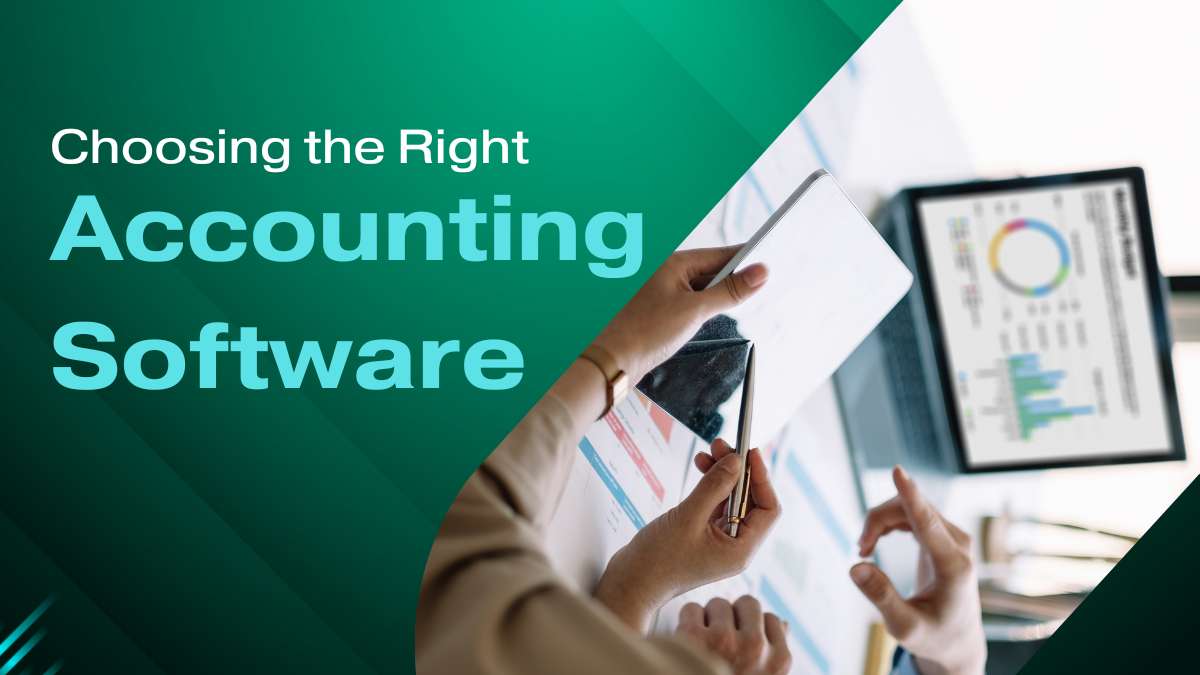
Choosing the Right Accounting Software: Your Beginner’s Guide to Smart Financial Management
Are you tired of wrestling with spreadsheets, drowning in receipts, or feeling completely overwhelmed by your business finances? You’re not alone. For many small business owners, freelancers, and even individuals looking to manage their personal wealth more effectively, the idea of "accounting" can feel like a daunting mountain to climb. But what if we told you there’s a powerful tool that can turn that mountain into a molehill? Enter accounting software.
Choosing the right accounting software isn’t just about finding a tool; it’s about finding a financial partner that simplifies your life, saves you time, and gives you a clear, real-time picture of your money. This comprehensive guide will walk you through everything you need to know, from understanding why you need it to picking the perfect solution for your unique needs.
Why You Absolutely Need Accounting Software
Gone are the days when accounting was solely the domain of bulky ledgers and complex spreadsheets. Modern accounting software is designed to be intuitive, efficient, and incredibly helpful. Here’s why investing in the right solution is a game-changer:
- Automated Bookkeeping: Say goodbye to manual data entry. Most software can automatically import transactions from your bank accounts and credit cards, categorize expenses, and reconcile accounts. This saves countless hours and reduces human error.
- Accurate Financial Reporting: Get instant, accurate reports like Profit & Loss (P&L) statements, Balance Sheets, and Cash Flow statements. These reports are vital for understanding your business health, making informed decisions, and impressing investors or lenders.
- Simplified Invoicing & Payments: Create professional invoices in minutes, track their status, and send automatic reminders. Many platforms also integrate with online payment gateways, making it easier for your clients to pay you quickly.
- Expense Tracking Made Easy: Snap photos of receipts, categorize expenses on the go, and easily track deductible business costs. This is a lifesaver come tax time.
- Tax Preparation Ready: With all your income and expenses meticulously recorded and categorized, preparing your taxes becomes significantly less stressful. Many software solutions can generate reports specifically designed for tax filing.
- Real-Time Financial Insights: See your cash flow, outstanding invoices, and overall financial performance at a glance. This empowers you to make proactive decisions rather than reactive ones.
- Better Cash Flow Management: Understand exactly where your money is coming from and where it’s going, helping you manage your budget and avoid financial surprises.
- Scalability: As your business grows, your accounting software can grow with you, handling more transactions, more employees, and more complex needs.
Key Factors to Consider When Choosing Accounting Software
Picking the right accounting software isn’t a one-size-fits-all decision. What works for a freelance graphic designer might not work for a growing retail business. Here are the crucial factors to weigh:
1. Your Business Needs & Size
This is the most critical starting point. Don’t buy a Ferrari when a bicycle will do, or vice versa.
- Small Business/Freelancer/Sole Proprietor: You likely need basic invoicing, expense tracking, and simple reporting. Focus on ease of use and affordability.
- Growing Business (with employees/inventory): You’ll need features like payroll, inventory management, more detailed reporting, and possibly multi-user access.
- Specific Industry Needs:
- Retail/E-commerce: Look for integrations with POS systems, inventory management, and online store platforms (e.g., Shopify, Etsy).
- Service-Based Businesses: Time tracking, project management, and recurring invoicing are key.
- Non-Profits: Fund accounting features might be necessary.
- Transaction Volume: How many invoices do you send? How many expenses do you track monthly? High volume might require a more robust system.
2. Your Budget
Accounting software comes in various pricing tiers, from free basic versions to premium plans with advanced features.
- Subscription Models: Most modern software operates on a monthly or annual subscription. Be clear on what each tier includes.
- Hidden Costs: Look out for extra charges for features like payroll, additional users, or premium support.
- Value vs. Cost: Don’t just pick the cheapest option. Consider the time saved and errors avoided. A slightly more expensive solution might pay for itself many times over.
- Free Options: While tempting, free software often comes with limitations (e.g., limited transactions, no advanced features, less support). They can be a good starting point for very small businesses or personal use, but often aren’t sustainable for growth.
3. Essential Features You Actually Need
Make a list of "must-have" and "nice-to-have" features. Don’t get swayed by a long list of features you’ll never use.
Core Features (Almost Everyone Needs):
- Invoicing: Create and send professional invoices.
- Expense Tracking: Record and categorize business expenses.
- Bank Reconciliation: Match your bank statements with your software’s records.
- Basic Reporting: Profit & Loss, Balance Sheet.
- Dashboard: An at-a-glance overview of your financials.
Advanced Features (Consider if Applicable):
- Payroll: Manage employee salaries, taxes, and deductions.
- Inventory Management: Track stock levels, costs, and sales.
- Time Tracking: For service-based businesses or project management.
- Project Management: Track profitability by project.
- Multi-Currency Support: If you deal with international clients or suppliers.
- Purchase Orders: For managing supplier orders.
- Budgeting & Forecasting: Plan and predict future financial performance.
- Fixed Asset Management: Track depreciation of assets.
4. Ease of Use & User-Friendliness
This is paramount, especially for beginners. If the software is confusing, you won’t use it.
- Intuitive Interface: Does it look clean and organized? Can you easily find what you’re looking for?
- Learning Curve: How long will it take you or your team to get comfortable with the system?
- Dashboard: Is the main dashboard easy to read and understand?
- Automation: How much can the software automate routine tasks?
5. Cloud-Based vs. Desktop Software
This is a major decision point.
Cloud-Based (Online/SaaS – Software as a Service):
- Pros:
- Access anywhere, anytime, from any device with an internet connection.
- Automatic updates (no need to install anything).
- Automatic data backups.
- Typically subscription-based.
- Easier collaboration with accountants/team members.
- Cons:
- Requires an internet connection.
- Data stored on external servers (security concerns for some, though reputable providers have robust security).
- Ongoing subscription costs.
Desktop-Based (On-Premise):
- Pros:
- Data stored directly on your computer (some prefer this for security).
- No internet connection required after initial installation (for basic use).
- One-time purchase fee (though updates may cost extra).
- Cons:
- Limited to the computer it’s installed on.
- Manual updates required.
- Manual data backups are crucial.
- Less convenient for collaboration.
- Often more complex to set up and maintain.
Recommendation for Beginners: For most small businesses and beginners, cloud-based software is overwhelmingly the better choice due to its accessibility, ease of maintenance, and automatic updates/backups.
6. Integrations with Other Tools
Your accounting software shouldn’t be an island. It needs to play nicely with other tools you use.
- Payment Gateways: PayPal, Stripe, Square, etc.
- CRM (Customer Relationship Management): Salesforce, HubSpot, Zoho CRM.
- E-commerce Platforms: Shopify, WooCommerce, Etsy.
- POS (Point-of-Sale) Systems: Square, Shopify POS.
- Time Tracking Software: Harvest, Toggl.
- Project Management Software: Asana, Trello.
- Banking: Direct bank feeds are incredibly helpful.
Seamless integrations reduce manual data entry and ensure all your business data is connected.
7. Security & Data Backup
Your financial data is sensitive. Ensure the software provider prioritizes security.
- Encryption: Look for strong data encryption (e.g., 256-bit SSL).
- Regular Backups: Cloud providers should have robust backup and disaster recovery protocols.
- Access Controls: Can you set different permission levels for users?
- Two-Factor Authentication (2FA): An extra layer of security for logging in.
8. Customer Support
Even the most intuitive software can present challenges. Good support is invaluable.
- Support Channels: Phone, email, live chat, knowledge base, community forums.
- Availability: What are their support hours?
- Response Time: How quickly do they typically respond to queries?
- Quality of Support: Are support agents knowledgeable and helpful?
- Onboarding Resources: Do they offer tutorials, webinars, or setup guides?
9. Scalability
Think about your business’s future. Can the software grow with you?
- Can you easily upgrade to a higher plan with more features as your needs expand?
- Does it support additional users if you hire staff?
- Can it handle increased transaction volume?
10. Reporting Capabilities
The whole point of tracking your finances is to gain insights.
- Customizable Reports: Can you tailor reports to see specific data?
- Pre-built Templates: Are there standard reports (P&L, Balance Sheet, Cash Flow) readily available?
- Visualizations: Does it offer charts and graphs for easier understanding?
Popular Accounting Software Options (Brief Overview)
While this guide focuses on how to choose, it’s helpful to be aware of some of the leading contenders in the market. Each has its strengths, catering to different business sizes and needs.
- QuickBooks Online: The market leader for small to medium-sized businesses. Very comprehensive, with a wide range of features and integrations. Can have a steeper learning curve for absolute beginners.
- Xero: A strong competitor to QuickBooks, often praised for its user-friendly interface and strong bank reconciliation features. Popular among small businesses and those who appreciate modern design.
- FreshBooks: Originally designed for freelancers and service-based businesses, it excels at invoicing, expense tracking, and time tracking. Very intuitive and easy to use.
- Wave Accounting: A popular free option for very small businesses and freelancers, offering basic invoicing, expense tracking, and reporting. Ideal for those with simple needs and a tight budget.
- Zoho Books: Part of the larger Zoho Suite, offering robust features at competitive prices. Good for businesses looking for an integrated ecosystem of tools (CRM, project management, etc.).
- Sage (various products): Offers a range of accounting solutions, from small business desktop versions to more comprehensive cloud solutions. Caters to a broad spectrum of businesses.
Remember: Don’t just pick one based on popularity. Use the factors above to see which one aligns best with your specific requirements.
Steps to Choosing Your Ideal Accounting Software
Now that you understand the key considerations, here’s a practical step-by-step approach:
-
Assess Your Current & Future Needs:
- What are your biggest financial pain points right now? (e.g., messy receipts, no idea of profitability, difficult tax prep).
- What specific tasks do you want the software to handle? (e.g., invoicing, payroll, inventory).
- How many employees do you have? Do you plan to hire more?
- What’s your current transaction volume, and how might it grow?
-
Determine Your Budget:
- How much are you willing to spend monthly or annually?
- Factor in potential growth – can you afford higher tiers if needed?
-
List Essential Features:
- Create a "must-have" list and a "nice-to-have" list based on your needs assessment.
-
Research & Shortlist Options:
- Based on your budget and essential features, research 3-5 software options. Read reviews, watch demo videos.
- Pay attention to user feedback regarding ease of use and customer support.
-
Take Advantage of Free Trials:
- Most reputable accounting software providers offer free trials (7, 14, or 30 days). This is your chance to "test drive" the software.
- During the trial, try to perform your most common tasks: create an invoice, enter an expense, connect your bank account, run a basic report. See how intuitive it feels.
-
Read Recent Reviews (But Be Discerning):
- Look at reviews on reputable software comparison sites (e.g., G2, Capterra, Software Advice).
- Pay attention to recent reviews, as software updates frequently.
- Look for patterns in complaints or praises.
-
Consider Implementation & Migration:
- How easy is it to set up? Do they offer onboarding support?
- If you’re moving from another system (even spreadsheets), how easy is it to import your existing data?
Conclusion: Empower Your Financial Future
Choosing the right accounting software is one of the smartest investments you can make for your business or personal finances. It’s not just about managing money; it’s about gaining clarity, saving time, reducing stress, and empowering yourself to make better, more informed financial decisions.
Don’t let the array of options intimidate you. By systematically evaluating your needs, understanding the key factors, and taking advantage of free trials, you’ll be well on your way to finding the perfect financial partner. Take the plunge – your future self (and your accountant!) will thank you.



Post Comment